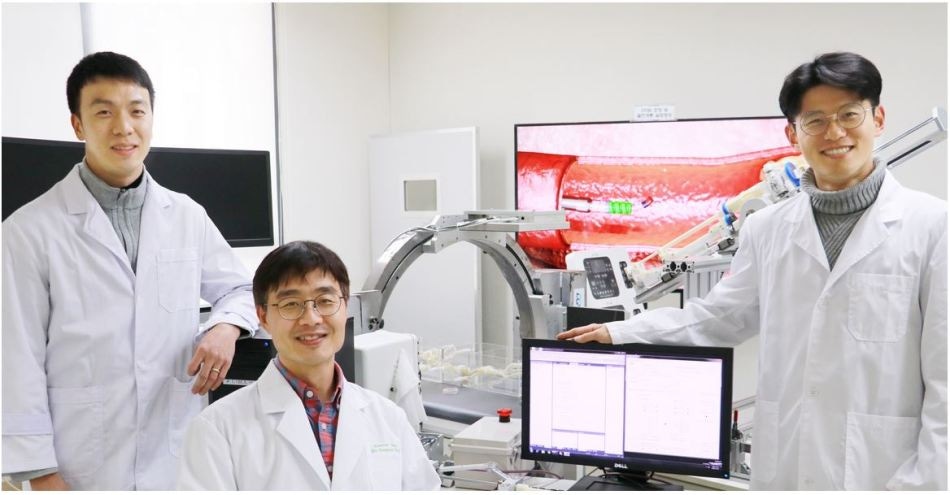Mar 6 2019
A research team at DGIST successfully developed a microrobot that can get to the accurate location of cardiovascular disease such as the Chronic Total Occlusion by moving and turning the microrobot toward a preferred direction inside complex blood vessels. This study is anticipated to improve the treatment success rate and reduce the time of cardiovascular disease surgery.
 Professor Hongsoo Choi (middle), Ph.D. student Seongwoong Jeon (left), and Ph.D. student Kangho Kim (right) in the Department of Robotics Engineering at DGIST who developed the attachable guidewire microrobot. (Image credit: DGIST)
Professor Hongsoo Choi (middle), Ph.D. student Seongwoong Jeon (left), and Ph.D. student Kangho Kim (right) in the Department of Robotics Engineering at DGIST who developed the attachable guidewire microrobot. (Image credit: DGIST)
On February 27th, 2019, DGIST reported that the team under Professor Hongsoo Choi in the Robotics Engineering Department created the “Magnetically Controlled Microrobot” that can increase the success rate of CTO treatment among myocardial infarctions through a cooperative research with Professor Byung-Ju Yi’s team at Hanyang University and Professor Bradley J Nelson’s team at idgenössische Technische Hochschule Zürich in Switzerland.
The guidewire used for percutaneous coronary intervention—which clears the blocked blood vessels—is manually controlled by a surgeon to change its direction and location; therefore, the speed and success rate of surgery are dependent on the skill level of the surgeon. It had been challenging to control the precise location and direction as the surgeon had to manually configure and drive the guidewire with bent ends inside complicated blood vessels or junction.
To overcome this challenge, the team led by Professor Choi employed flexible and biocompatible polymer and neodymium magnet that can control the direction and location with an external magnetic field. With the help of this, the researchers created a cylindrical microrobot that is 500 µm in diameter and 4 mm in length and fixed it at the end of the guidewire. The researchers created an attachable guidewire soft microrobot that can drive the guidewire toward the desired direction by controlling the microrobot with the external magnetic field and allow a rectilinear motion via Master-Slave System.
The scientists were also successful in an experiment which mathematically estimates and predicts the motion of the microrobot and penetrates complex blood vessels via the feedforward method to control the outcome, to achieve flexible, nonlinear motions of microrobot. Furthermore, the researchers succeeded in an experiment to get to the desired region in a 3D blood vessel model that mimics the coronary artery of the heart and achieve the biocompatibility of the microrobot from a cell survival experiment.
The attachable guidewire microrobot designed by the scientists allows rectilinear motions via precise control by magnetic field and Master-Slave system. This can help get to a desired location inside the complicated blood vessel much quicker, thereby helping to overcome the percutaneous coronary intervention of current surgical technique and enhancing the success rate and efficiency of surgery. It will also minimize the exposure of the patient and the surgeon to X-ray radiation as well as decrease blood vessel damage of patients since it can get to at the diseased part more rapidly when compared to the current method.
Compared to the existing method, using an attachable guidewire microrobot will shorten the time for heart disease surgery and increase the success rate by enabling the surgeon to find the cause of disease more accurately and faster for a stable surgery. Our research team will work harder to conduct follow-up research with related companies and develop products that can be used in medical sites.
Professor Hongsoo Choi, Department of Robotics Engineering, DGIST
Meanwhile, this R&D result featured as a cover paper on Soft Robotics, the world-renowned international journal in robot research. The study was carried out with the support of Ministry of Trade, Industry, and Energy and also the Ministry of Science and ICT.